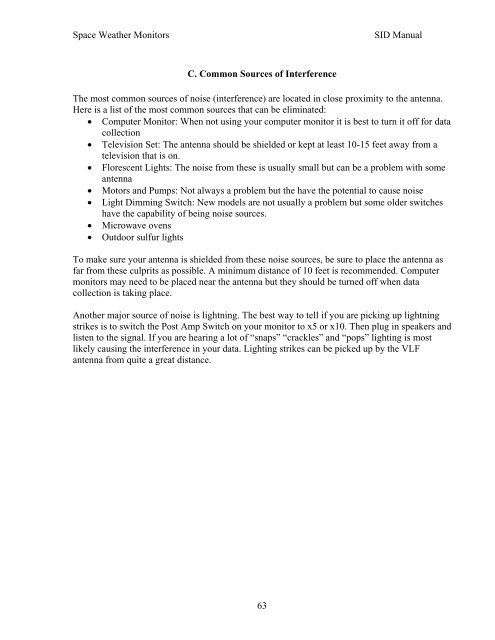Space Weather Monitors SID Users Manual - Stanford Solar Center ...
Space Weather Monitors SID Users Manual - Stanford Solar Center ...
Space Weather Monitors SID Users Manual - Stanford Solar Center ...
Create successful ePaper yourself
Turn your PDF publications into a flip-book with our unique Google optimized e-Paper software.
<strong>Space</strong> <strong>Weather</strong> <strong>Monitors</strong> <strong>SID</strong> <strong>Manual</strong><br />
C. Common Sources of Interference<br />
The most common sources of noise (interference) are located in close proximity to the antenna.<br />
Here is a list of the most common sources that can be eliminated:<br />
• Computer Monitor: When not using your computer monitor it is best to turn it off for data<br />
collection<br />
• Television Set: The antenna should be shielded or kept at least 10-15 feet away from a<br />
television that is on.<br />
• Florescent Lights: The noise from these is usually small but can be a problem with some<br />
antenna<br />
• Motors and Pumps: Not always a problem but the have the potential to cause noise<br />
• Light Dimming Switch: New models are not usually a problem but some older switches<br />
have the capability of being noise sources.<br />
• Microwave ovens<br />
• Outdoor sulfur lights<br />
To make sure your antenna is shielded from these noise sources, be sure to place the antenna as<br />
far from these culprits as possible. A minimum distance of 10 feet is recommended. Computer<br />
monitors may need to be placed near the antenna but they should be turned off when data<br />
collection is taking place.<br />
Another major source of noise is lightning. The best way to tell if you are picking up lightning<br />
strikes is to switch the Post Amp Switch on your monitor to x5 or x10. Then plug in speakers and<br />
listen to the signal. If you are hearing a lot of “snaps” “crackles” and “pops” lighting is most<br />
likely causing the interference in your data. Lighting strikes can be picked up by the VLF<br />
antenna from quite a great distance.<br />
63



